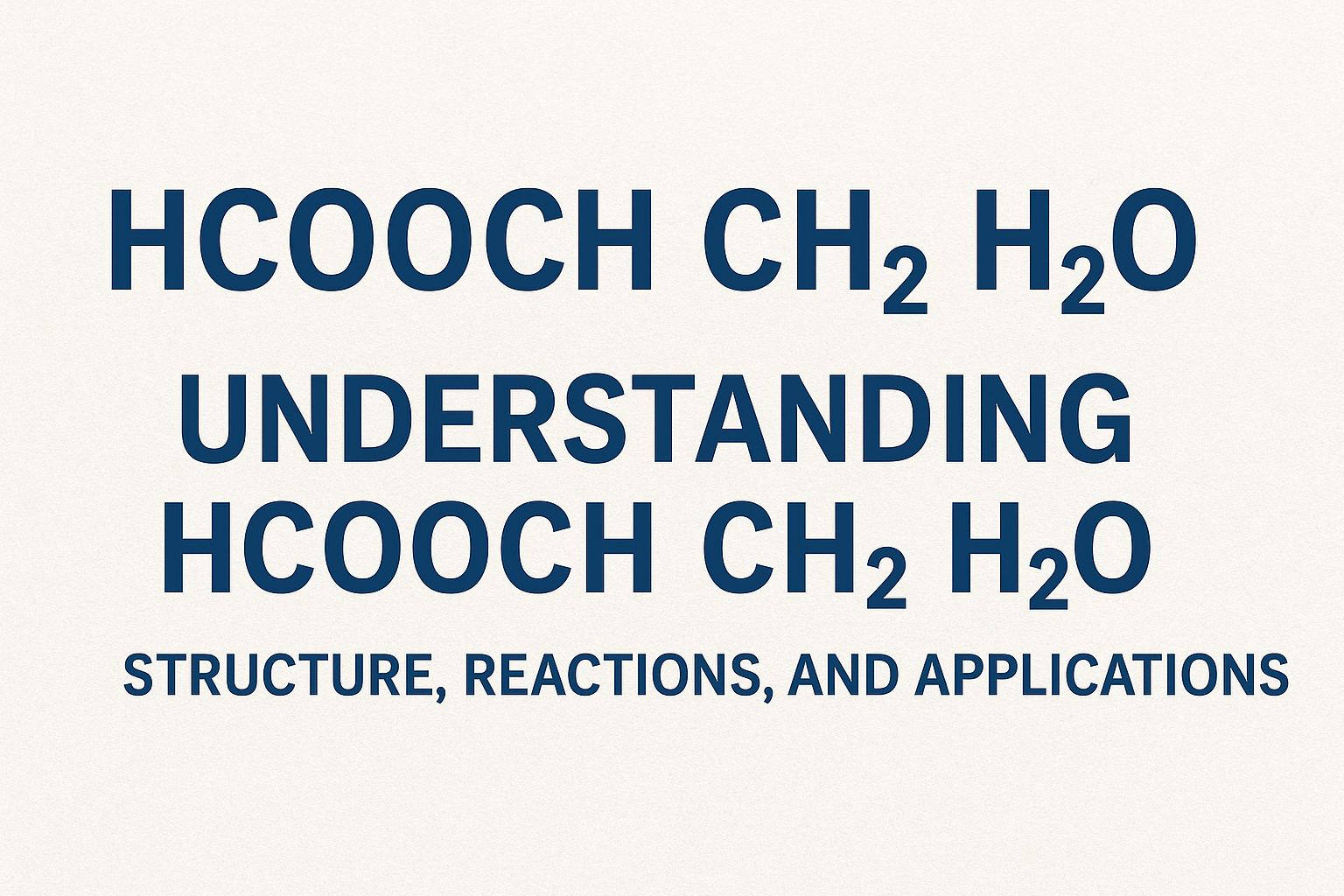
In chemistry, certain notations or condensed formulas may at first appear confusing, but on closer inspection, they often reveal fascinating insights into molecular structures and chemical reactions. One such example is the keyword hcooch ch2 h2o, a sequence of letters and numbers that seems to represent fragments of molecules or a shorthand for a chemical process. While it does not directly correspond to a single standardized compound in the International Union of Pure and Applied Chemistry (IUPAC) database, the elements within hcooch ch2 h2o clearly echo familiar molecular groups. By breaking it down into its parts—hcooch, ch2, and h2o—we can identify formate derivatives, methylene groups, and water molecules. Each of these has enormous significance in the study of organic chemistry, biochemistry, and industrial science. Therefore, analyzing the meaning and applications of hcooch ch2 h2o provides an opportunity to understand not only chemical notation but also the deep connections between fundamental molecules and practical technologies.
Breaking Down the Components of hcooch ch2 h2o
To make sense of hcooch ch2 h2o, it is essential to examine each part. The first fragment, hcooch, strongly resembles the notation for a formate ester such as methyl formate (HCOOCH3). Formates are derived from formic acid, the simplest carboxylic acid, which plays a role in both nature and industry. The second part, ch2, represents a methylene group, a structural unit found in countless organic molecules. Methylene bridges give stability to polymers and flexibility to organic compounds, and they often appear in hydrocarbons, amino acids, and biologically active molecules. Finally, h2o, which is universally recognized as water, could represent either a reactant or a product in the context of hcooch ch2 h2o. Taken together, this keyword suggests a possible hydration or hydrolysis process involving a formate ester and a methylene-containing compound. While this is not a definitive interpretation, it opens pathways for exploring the chemical and practical significance of such a notation.
Chemical Reactions Involving hcooch ch2 h2o
The keyword hcooch ch2 h2o may point toward a reaction rather than a standalone molecule. In organic chemistry, esters such as formates undergo hydrolysis in the presence of water, breaking down into alcohols and acids. For example, methyl formate reacts with water under acidic or basic conditions to yield methanol and formic acid. If the ch2 fragment refers to a methylene group attached to an ester chain, then hcooch ch2 h2o could signify a reaction where water attacks the ester bond, producing smaller, functional molecules. Such hydrolysis reactions are not only central in laboratory synthesis but also mirror processes in living organisms. In biological systems, ester hydrolysis plays a key role in metabolism and energy transfer. Therefore, interpreting hcooch ch2 h2o as shorthand for hydrolytic activity allows us to connect the keyword to both industrial and biological chemistry.
Industrial Applications Linked to hcooch ch2 h2o
Formate compounds, methylene groups, and water reactions are all deeply embedded in industrial chemistry, and by extension, so is the concept of hcooch ch2 h2o. Formates like methyl formate are widely used as intermediates in producing formamide, an important compound in pharmaceuticals and agriculture. In the energy sector, formate salts are being studied as hydrogen carriers, which could revolutionize clean energy technologies. Methylene groups, represented by ch2, are crucial in polymer chemistry, forming the backbones of plastics such as polyethylene and polypropylene. The h2o component of hcooch ch2 h2o further underscores the centrality of water as both a solvent and a reactant in industrial processes. Taken together, the keyword highlights the interconnectedness of basic chemical building blocks in producing materials, fuels, and medicines that sustain modern society.
Biological Significance of hcooch ch2 h2o
Beyond industrial uses, the components of hcooch ch2 h2o have deep biological implications. Formates are part of one-carbon metabolism, a crucial pathway that governs DNA synthesis and energy transfer in cells. The methylene group, ch2, appears in amino acids and metabolic intermediates that form the basis of proteins and enzymes. Water, h2o, is the universal solvent of life, essential for maintaining biological structure and facilitating biochemical reactions. If we interpret hcooch ch2 h2o as representing an ester undergoing hydrolysis, then the process is analogous to how enzymes in the human body break down dietary fats, releasing fatty acids and glycerol for energy. Thus, the seemingly cryptic keyword hcooch ch2 h2o actually ties into fundamental processes that sustain both cellular life and human health.
Educational Importance of hcooch ch2 h2o
For students and educators, hcooch ch2 h2o offers a valuable exercise in deciphering condensed chemical notation. Many times in textbooks, lab manuals, or lecture notes, complex structures are abbreviated for convenience, leaving learners with the challenge of interpreting what is truly being represented. By analyzing hcooch ch2 h2o, students practice skills such as breaking down molecular fragments, identifying functional groups, and hypothesizing potential reactions. Teachers can use such examples as puzzles to encourage critical thinking, asking students to write balanced chemical equations based on their interpretations. Beyond the classroom, developing the ability to decode shorthand like hcooch ch2 h2o prepares future chemists for real-world research, where time-saving notations and fragment-based representations are commonplace.
Misconceptions and Clarifications About hcooch ch2 h2o
A common misconception is to assume that hcooch ch2 h2o represents a complete, officially recognized chemical compound. In reality, it is best understood as a shorthand or a symbolic representation of fragments that hint at reactions involving formates, methylene groups, and water. Another misunderstanding is that the keyword lacks meaning because it does not appear in chemical databases. However, as demonstrated, the fragments within hcooch ch2 h2o have rich scientific importance and practical relevance. Recognizing that not all chemical notations are standardized teaches flexibility in approaching scientific texts and experimental data. This mindset is crucial for advanced learners and professionals, as the real world of chemistry often involves creative shorthand notations that go beyond textbook definitions.
Future Perspectives on hcooch ch2 h2o
Looking ahead, the building blocks represented in hcooch ch2 h2o may play pivotal roles in advancing sustainable technologies. Formate chemistry is being studied for its potential in carbon capture and hydrogen storage, offering environmentally friendly solutions to the energy crisis. Methylene-based polymers are evolving toward biodegradable and recyclable forms, aligning with the push for sustainable materials. Water, already indispensable in countless reactions, is increasingly central in green chemistry, where it is favored as a solvent over toxic organic alternatives. As researchers innovate, notations like hcooch ch2 h2o may emerge more frequently in academic and industrial literature, serving as compact ways of representing critical reaction pathways. Thus, the keyword is not just a curiosity—it could become a marker of forward-looking chemistry.
Conclusion
The keyword hcooch ch2 h2o, while not directly a standard molecular formula, encapsulates essential fragments that point to meaningful concepts in chemistry. With hcooch suggesting formate esters, ch2 representing methylene groups, and h2o symbolizing water, the notation can be understood as shorthand for hydrolytic or hydration reactions central to both industrial and biological systems. By unpacking hcooch ch2 h2o, we uncover links to polymer chemistry, pharmaceutical synthesis, green energy solutions, and metabolic pathways in living organisms. Its study highlights the value of careful interpretation in chemistry, where even a compressed formula can reveal a wealth of scientific insights. In the end, hcooch ch2 h2o serves as a reminder that behind every symbol lies a story of molecules, reactions, and the profound ways in which chemistry shapes our world.


